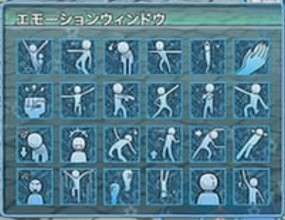Emote Animation
Using an Emote Command in some games (especially MMORPGs) will trigger Emote Animations. Sometimes, these are also used as Idle Animations, or recycled by the devteam for cutscenes.
Examples of Emote Animation include:
- In World of Warcraft, the Slash Command "/dance" triggers a different dancing animation depending on the race and gender of your character. For example, male dwarfs will perform a "Cossack" dance, while female dwarfs will perform some Riverdance-esque Irish step-dancing.
- There are other animations as well. /rude, /train /roar, being a few examples
- City of Heroes has over two hundred of these, including five different "/dance"s, a half-dozen variations on "/sit", eating, drinking, beating someone with a baseball bat, turning someone into a pumpkin, being turned into a pumpkin by someone, plotting evilly, and inviting someone to kiss your butt. Furthermore, new ones seem to be added with every major release of the game.
- The Lord of the Rings Online also includes over a hundred of animations with new ones being added frequently. Several dozens are the basic ones, rest are unlockable through gameplay. Many quests require you to perform certain animations to progress. Also, there are at least twelve different emotes for various dances alone.
- The Matrix Online includes several selectable dances which differ based on gender as well as a collection of interactive emotes. Players can either accept the emote or decline it, such as /kiss, /propose, /manhug, and /dap.
- Guild Wars also includes several, with dance (based on character profession) included. Also notable are /flute and /guitar ("Rostafan plays a mean air guitar.")
- Bored EverQuest players proved that it's possible to make any character dance the macarena with stock emotes.
- While many multiplayer shooters have emotes (mostly victory gloats), the cult of multiplayer saber fighting in the later Dark Forces Saga games caused the developers to eventually add thirty different default emote animations.
- The child-targeted animation program 3D Movie Maker has various over-acted emotes for each character model (sit, talk, walk, etc). Thankfully for the movie makers, there's an option to pause the animations at a given frame, leading to entire movies where all character motions are built out of various mix-and-matched frames of other animations.
- Asheron's Call 2 has, amongst its more generic emotes, the "gokart" emote, which would cause a player to remain in a sitting position while moving.
- Final Fantasy XI actually has made multiple updates to its emotes. An early patch after the initial US release (later known as the "sitting nerf") changed the /sit emote for female characters so their legs weren't spread quite so wide. More recently the various dancing animations used for the Dancer job class were added as new /dance emotes.
- Puppeteers' animations will perform emotes along with their masters.
- Fable I has a wide variety emote animations. Despite it being a single-player game, they're actually useful: you use them for romancing women, frightening villagers, flipping off guards and farting to make children giggle. They're really quite useful in getting a wife, and for showing off trophies for extra renown.
- Fable II allows the player to "extend" certain emotes for better results with the caveat that, the longer the emote is extended, the greater the chance to fail. Failure can be funnier than success: failing the fart emote results in the player soiling themselves.
- The now-defunct Earth and Beyond space MMORPG had emotes for your character and your ship; yaw spins, barrel rolls, short loop-the-loops, all performed without influencing the direction of flight or breaking formation.
- Mabinogi added emotes for greeting, laughing, crying, and being angry, among others, around it's 1-year anniversary in North America. As of mid-August 2010, further animations for salutes, formal greetings, and dancing were added.
- Tales of Symphonia has a mini-game in which the stock emotes are mapped to random keys on the controller, and the player must trigger emotes to match the demonstrating NPC.
- In Toontown Online, this varies from waving hello, to applauding, to growling, to growling with an organ playing in the background.
- The Wii A Boy and His Blob features a "hug Blob" button. Which is just plain adorable to watch.
- Army of Two includes "Bromance" type stuff where you can high five your co-op team-mate, or shake hands or whatever.
- Or smack them. This will usually completely derail a mission for several minutes as players continually smack each other.
- The 2008 Prince of Persia game has a dedicated button for activating conversation between the Prince and Elika. The conversations do include snippets of the backstory, however.
- RuneScape has a few dozens of emote animations. Some are given out during certain holiday events, others are unlocked by completing requirements, and still others are only activated through the use of a specific item, weapon, or costume/cape.
- Flyff has quite a few of these.
- Portal 2's co-op, features gestures.
- Dragon Quest IX has "Party Tricks", many of which are given out as rewards as you complete quests. They were most likely added because of the game's increased focus on multiplayer.
- League of Legends features a joke, taunt, dance and laughing emote for each champ, most of which come with its own animation.
- These are the only ways players can directly communicate in Dark Souls.
This article is issued from Allthetropes. The text is licensed under Creative Commons - Attribution - Sharealike. Additional terms may apply for the media files.
